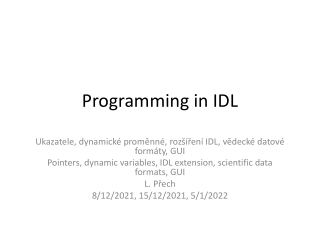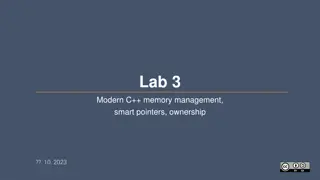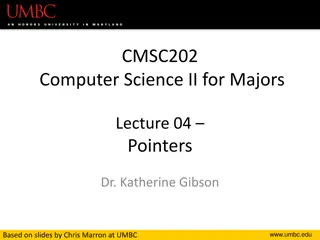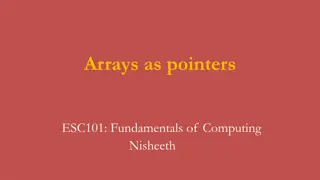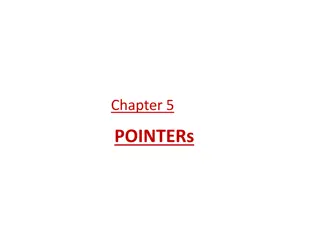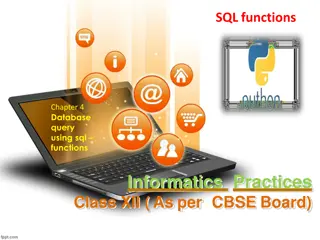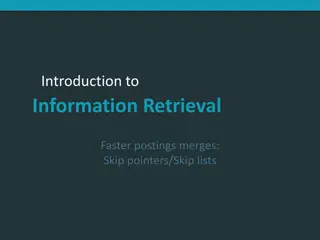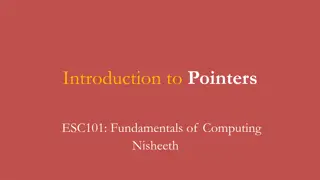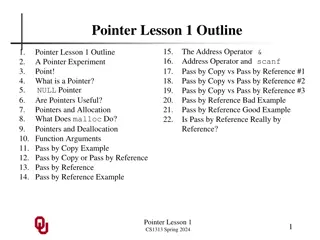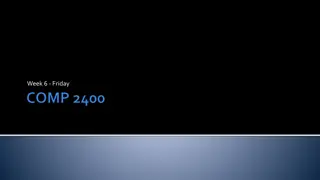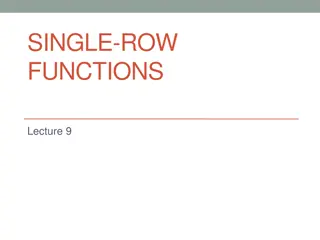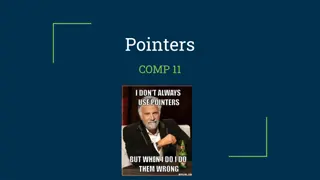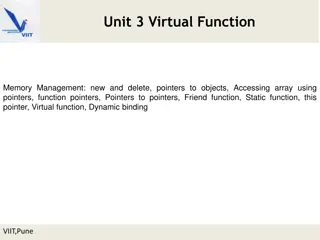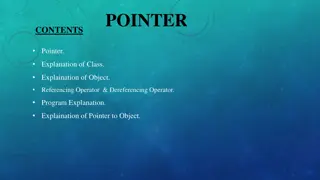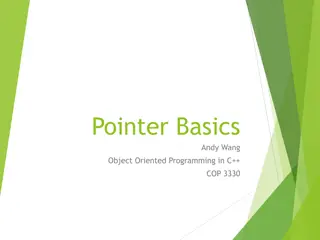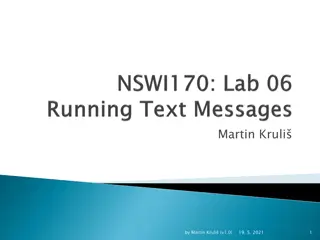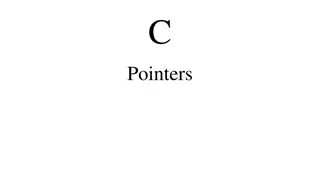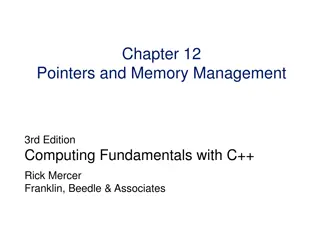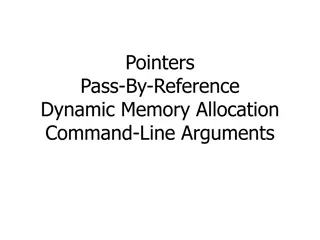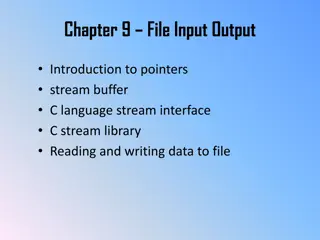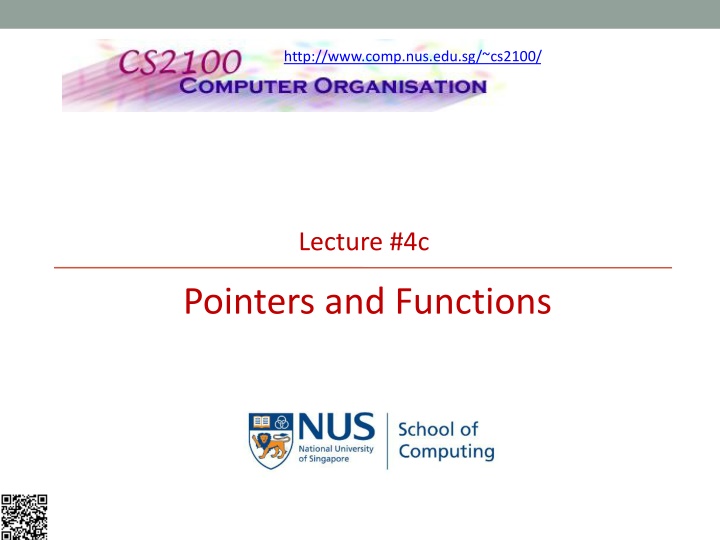
Pointers and Functions in C Programming
Explore the usage of pointers and functions in C programming with insights on calling functions, using libraries, and defining user-defined functions. Learn how to work with math functions and create your own functions for practical computations.
Download Presentation

Please find below an Image/Link to download the presentation.
The content on the website is provided AS IS for your information and personal use only. It may not be sold, licensed, or shared on other websites without obtaining consent from the author. If you encounter any issues during the download, it is possible that the publisher has removed the file from their server.
You are allowed to download the files provided on this website for personal or commercial use, subject to the condition that they are used lawfully. All files are the property of their respective owners.
The content on the website is provided AS IS for your information and personal use only. It may not be sold, licensed, or shared on other websites without obtaining consent from the author.
E N D
Presentation Transcript
http://www.comp.nus.edu.sg/~cs2100/ Lecture #4c Pointers and Functions
Questions? IMPORTANT: DO NOT SCAN THE QR CODE IN THE VIDEO RECORDINGS. THEY NO LONGER WORK Ask at https://sets.netlify.app/module/676ca3a07d7f5ffc1741dc65 OR Scan and ask your questions here! (May be obscured in some slides)
Aaron Tan, NUS Lecture #4: Pointers and Functions 3 2. Calling Functions (1/3) In C, there are many libraries offering functions for you to use. Eg: scanf() and printf() requires to include <stdio.h> C provides many libraries, for example, the math library To use math functions, you need to Include <math.h> AND Compile your program with lm option (i.e. gcc lm ) in sunfire See table (next slide) for some math functions
Aaron Tan, NUS Lecture #4: Pointers and Functions 4 2. Calling Functions (2/3) Function prototype: double pow(double x, double y) function return type
Aaron Tan, NUS Lecture #4: Pointers and Functions 5 2. Calling Functions (3/3) To link to Math library MathFunctions.c $ gcc lm MathFunctions.c $ a.out Enter x and y: 3 4 pow(3,4) = 81.000000 Enter value: 65.4 #include <stdio.h> #include <math.h> int main(void) { int x, y; float val; sqrt(65.400002) = 8.087027 printf("Enter x and y: "); scanf("%d %d", &x, &y); printf("pow(%d, %d) = %f\n", x, y, pow(x,y)); printf("Enter value: "); scanf("%f", &val); printf("sqrt(%f) = %f\n", val, sqrt(val)); return 0; }
Aaron Tan, NUS Lecture #4: Pointers and Functions 6 3. User-Defined Functions (1/6) We can define and use our own functions Example: Compute the volume of a flat washer. Dimensions of a flat washer are usually given as an inner diameter, an outer diameter, and a thickness. rim area = (d2/2)2 (d1/2)2
Aaron Tan, NUS Lecture #4: Pointers and Functions 7 3. User-Defined Functions (2/6) Washer.c #include <stdio.h> #include <math.h> #define PI 3.14159 int main(void) { double d1, // inner diameter d2, // outer diameter thickness, outer_area, inner_area, rim_area, volume; Enter : 8.2 10.5 2.2 Volume of washer = 74.32 // read input data printf("Enter inner diameter, outer diameter, thickness: "); scanf("%lf %lf %lf", &d1, &d2, &thickness); // compute volume of a washer outer_area = PI * pow(d2/2, 2); inner_area = PI * pow(d1/2, 2); rim_area = outer_area - inner_area; volume = rim_area * thickness; printf("Volume of washer = %.2f\n", volume); return 0; }
Aaron Tan, NUS Lecture #4: Pointers and Functions 8 3. User-Defined Functions (3/6) Note that area of circle is computed twice. For code reusability, it is better to define a function to compute area of a circle. double circle_area(double diameter) { return PI * pow(diameter/2, 2); } We can then call/invoke this function whenever we need it. circle_area(d2) to compute area of circle with diameter d2 circle_area(d1) to compute area of circle with diameter d1
Aaron Tan, NUS Lecture #4: Pointers and Functions 9 3. User-Defined Functions (4/6) WasherV2.c #include <stdio.h> #include <math.h> #define PI 3.14159 Function prototype double circle_area(double); int main(void) { // code similar to Washer.c; omitted here // compute volume of a washer rim_area = circle_area(d2) circle_area(d1); volume = rim_area * thickness; printf("Volume of washer = %.2f\n", volume); return 0; } // This function returns the area of a circle double circle_area(double diameter) { return PI * pow(diameter/2, 2); } Function definition
Aaron Tan, NUS Lecture #4: Pointers and Functions 10 3. User-Defined Functions (5/6) It is a good practice to put function prototypes at the top of the program, before the main() function, to inform the compiler of the functions that your program may use and their return types and parameter types. A function prototype includes only the function s return type, the function s name, and the data types of the parameters (names of parameters are optional). Function definitions to follow after the main() function. Without function prototypes, you will get error/warning messages from the compiler.
Aaron Tan, NUS Lecture #4: Pointers and Functions 11 3. User-Defined Functions (6/6) Let s remove (or comment off) the function prototype for circle_area() in WashersV2.c Messages from compiler: WashersV2.c: In function main : WashersV2.c:19:2: warning: implicit declaration of function circle_area [-Wimplicit-function-declaration] rim_area = circle_area(d2) circle_area(d1); ^ WasherV2.c: At top level: WashersV2.c:27:8: error: conflicting types for circle-area : Without function prototype, compiler assumes the default (implicit) return type of int for circle_area() when the function is used in line 19, which conflicts with the function header of circle_area() when the compiler encounters the function definition later in line 27.
Aaron Tan, NUS Lecture #4: Pointers and Functions 12 End of File

